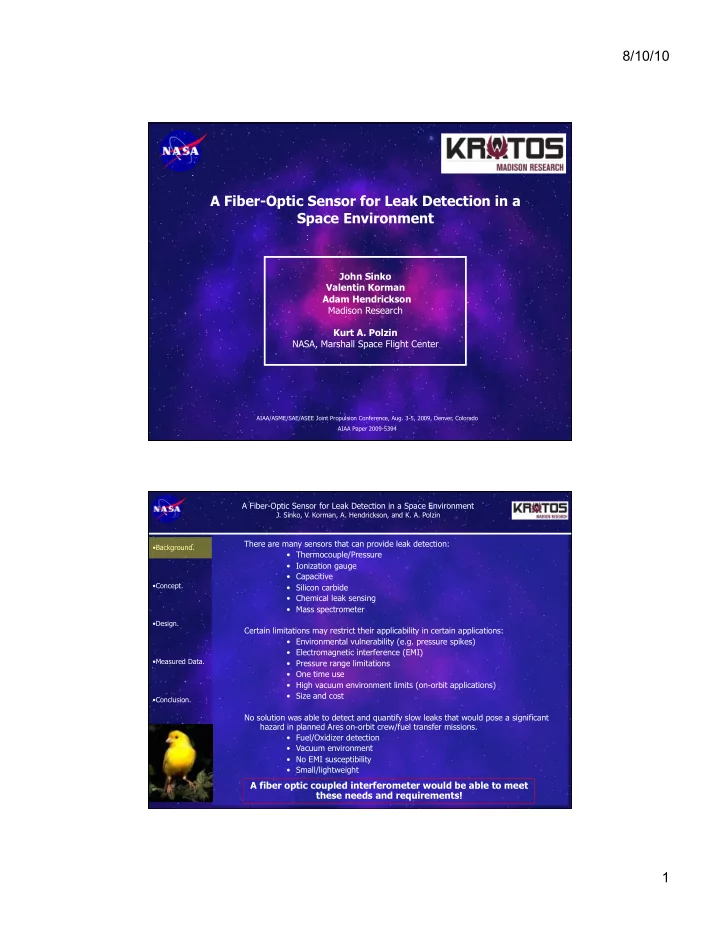

8/10/10 A Fiber-Optic Sensor for Leak Detection in a Space Environment John Sinko Valentin Korman Adam Hendrickson Madison Research Kurt A. Polzin NASA, Marshall Space Flight Center AIAA/ASME/SAE/ASEE Joint Propulsion Conference, Aug. 3-5, 2009, Denver, Colorado AIAA Paper 2009-5394 A Fiber-Optic Sensor for Leak Detection in a Space Environment J. Sinko, V. Korman, A. Hendrickson, and K. A. Polzin There are many sensors that can provide leak detection: • Background. • Thermocouple/Pressure • Ionization gauge • Capacitive • Concept. • Silicon carbide • Chemical leak sensing • Mass spectrometer • Design. Certain limitations may restrict their applicability in certain applications: • Environmental vulnerability (e.g. pressure spikes) • Electromagnetic interference (EMI) • Measured Data. • Pressure range limitations • One time use • High vacuum environment limits (on-orbit applications) • Size and cost • Conclusion. No solution was able to detect and quantify slow leaks that would pose a significant hazard in planned Ares on-orbit crew/fuel transfer missions. • Fuel/Oxidizer detection • Vacuum environment • No EMI susceptibility • Small/lightweight A fiber optic coupled interferometer would be able to meet these needs and requirements! 1
8/10/10 A Fiber-Optic Sensor for Leak Detection in a Space Environment J. Sinko, V. Korman, A. Hendrickson, and K. A. Polzin An established relationship exists between the observed fringe • Background. shift/spacing and the gas density/pressure. • Concept. Single-pass interference condition • Design. • Measured Data. Lorentz-Lorenz equation • Conclusion. Rate of pressure change with respect to the order A Fiber-Optic Sensor for Leak Detection in a Space Environment J. Sinko, V. Korman, A. Hendrickson, and K. A. Polzin • Background. • Concept. • Design. • Measured Data. gas sensing interferometer • Conclusion. 2
8/10/10 A Fiber-Optic Sensor for Leak Detection in a Space Environment J. Sinko, V. Korman, A. Hendrickson, and K. A. Polzin • Background. • Concept. • Design. • Measured Data. • Conclusion. • Constant 1500 sccm gas injection rate • Fringe spacings compare favorably with theory for air, N 2 , Ar • Non-uniform spacing for He (large difference in Molar refractivity (A)) A Fiber-Optic Sensor for Leak Detection in a Space Environment J. Sinko, V. Korman, A. Hendrickson, and K. A. Polzin • Background. • Slow leak data • Pressure resolution on air below 10 mtorr • Concept. • Design. • Measured Data. Fast gas injection setup • Conclusion. 3
8/10/10 A Fiber-Optic Sensor for Leak Detection in a Space Environment J. Sinko, V. Korman, A. Hendrickson, and K. A. Polzin Notional response • Fast, transient gasdynamic • Background. events and waves are captured. • Measurements are in-line with the notional response • Concept. • Measurements on order of photodiode response time • Design. • Measured Data. • Conclusion. A Fiber-Optic Sensor for Leak Detection in a Space Environment J. Sinko, V. Korman, A. Hendrickson, and K. A. Polzin • Background. • Exists a need to detect and quantify slow leaks on-orbit that might endanger a mission or crew. • No solution to this problem that was capable of • Concept. • Fuel/Oxidizer detection • Vacuum environment • No EMI susceptibility • Design. • Small/lightweight • A fiber-coupled, solid body interferometer was demonstration tested as a possible solution • Measured Data. • Results • General agreement between predicted and measured interferometer response • Conclusion. • Sensor resolution demonstrated at under 10 mtorr pressure change • Showed capability to acquire time-resolved, transient data that resolved bulk pressure variations and much faster gasdynamic pressure oscillations • Theory shows that much higher levels of resolution are possible using a combination of present solid-body optics / MOEMS manufacturing techniques 4
Recommend
More recommend